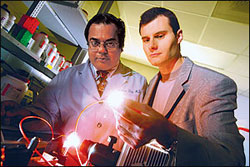EVANSTON, Ill., Oct. 1, 2008 – Researchers at NorthShore University HealthSystem and Northwestern University have discovered that fiber optic technology can enhance polyp detection and improve colon cancer prevention.
The study, which will appear in the Oct. 2008 issue of Gastroenterology (AGA), found that for the very first time fiber optic technology can effectively measure blood levels in the colonic lining (mucosa) in humans.
The researchers used fiber optic technology to map microvascular blood content in patients during colonoscopy. The results provide the first indication that the early increase in blood supply (EIBS) is detectable in humans and that a high blood level mirrors proximity to neoplasia, which is a process of tumor formation.
"Our premise is that since the lining of the large intestine - rectum and colon - is contiguous, if you see an abnormality in one part of the colon, then somewhere else in the colon you have a higher likelihood of harboring an adenoma (benign tumor) or carcinoma (malignant tumor)," said Hemant K. Roy, director of gastroenterology research at NorthShore University HealthSystem and the study's principal clinical researcher. "EIBS strengthens our premise thanks largely to the unique and accurate ability of Four Dimensional Elastic Light Scattering Fingerprinting (4D-ELF)."
Hemant Roy and Vadim Backman. Photo courtesy of Evanston Northwestern Healthcare.
This state-of-the-art light probe was developed by Vadim Backman, professor of biomedical engineering at Northwestern University's McCormick School of Engineering and Applied Science. It utilizes a revolutionary light scattering technology that can detect subtle abnormal changes in cells lining the colon long before those changes can be seen under a microscope, and even before polyps form.
"It's fascinating," said Roy, "to very precisely know that you're looking at the most superficial layer of tissue, which is where all polyps and cancer start, and the accuracy with which these things can be measured."
Researchers used the optic probe to measure oxygenated (Ohb) and deoxygenated (Dhb) hemoglobin (Hb) specifically in the colonic lining where small blood vessels circulate. At NorthShore's Evanston Hospital, 222 patients undergoing colonoscopy screening were recruited for the study in 2006-07.
Of these patients, 175 had no adenomas detected, 35 had non-advanced adenomas and 12 had advanced adenomas (polyps larger than one centimeter). The mean age was 56.6 years and 40 percent were female. There were no significant differences in gender. The groups did not significantly differ in tobacco or alcohol history.
The study found that the total Hb concentration was elevated 75.3 percent above control levels (comparable region from patients with no adenomas) at the adenoma site and persisted in the uninvolved mucosa (microscopically normal) area. Moreover, tissue sites located within 10 and 30 cm away from an adenoma also manifested a highly statistically significant increase in total Hb, OHb and DHb concentration."We are not determining whether an abnormality is cancer or not cancer," said Roy. "What we are doing is using optical technology to determine if we can assess risk through looking at field carcinogenesis (cancer formation). The potential clinical applications included enhance polyp detection during colonoscopy."
While the technology is still in the clinical trial phase," notes Michael Goldberg, head of gastroenterology at NorthShore University HealthSystem, "it could be available to patients at NorthShore in five years."
Colon cancer is the second-leading cause of cancer death in the United States, killing 55,000 Americans each year. The disease is 90 percent preventable if pre-cancerous polyps are detected early and removed.
"This partnership with Dr. Backman at Northwestern University has the potential of bringing a suite of technologies that is not meant to replace colonoscopy," said Roy, "but rather to more precisely determine risk and thereby help to individualize recommendations on the timing of colonoscopy for colon cancer screening. This improved efficiency and accuracy may aid in cancer prevention efforts."
For more information, visit: www.northwestern.edu